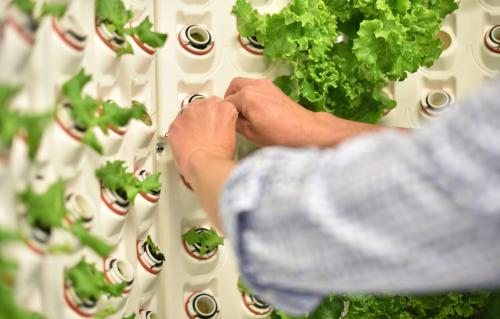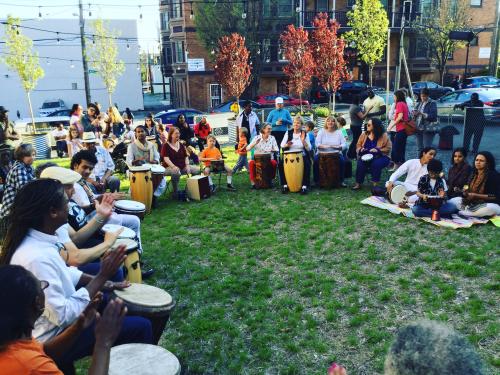Placemaking Postcards is a blog series from the Bass Center for Transformative Placemaking at Brookings where policymakers and practitioners guest-author promising placemaking efforts from across the U.S. and abroad that foster connected, vibrant, and inclusive communities. In line with the principle tenets of placemaking, the goal of the series is to recognize the community as the expert, highlight voices from the field, and to create a community of learning and practice around transformative placemaking.
 With the country caught in limbo between reopening and combatting the resurgence of COVID-19, the pandemic’s effects on small businesses and communities are only beginning to unfold. Between March and early May, more than 100,000 small businesses across the country closed their doors for good, and in the months since, businesses are closing at even higher rates. Microbusinesses (those with fewer than five employees) are particularly vulnerable, meaning cities and towns risk losing their “third places” that provide valuable cultural spaces and economic benefits.
With the country caught in limbo between reopening and combatting the resurgence of COVID-19, the pandemic’s effects on small businesses and communities are only beginning to unfold. Between March and early May, more than 100,000 small businesses across the country closed their doors for good, and in the months since, businesses are closing at even higher rates. Microbusinesses (those with fewer than five employees) are particularly vulnerable, meaning cities and towns risk losing their “third places” that provide valuable cultural spaces and economic benefits.
In New York City—where the pandemic’s economic ramifications hit hardest and earliest—the city’s small businesses are still struggling to hold on. Commercial tenants are falling behind in rent payments at unprecedented rates and many long-standing establishments and cultural institutions have permanently shuttered. Fears abound regarding the city’s ability to regain its vibrancy and sense of place after the crisis subsides.
Public markets play a critical role in this uncertain landscape. Not only do they provide essential foods and services, they also support independent retailers who are at heightened risk of closure and help places retain their unique, local character. This week is National Farmers Market Week, which is meant to nationally recognize the value markets bring to their communities. To mark the occasion, this piece will take a closer look at how one New York City public market is adapting to the ever-shifting COVID-19 crisis, supporting a diverse family of independent vendors, and providing a semblance of place during this uncertain time.
Preserving culture and history in place
Essex Market, a historic public marketplace in New York City’s Lower East Side, has a long history of serving as a space for gathering, cultural expression, and local entrepreneurship through times of both prosperity and crisis. In an economy that favors supermarket chains and big-box retailers, this is a vital, yet precarious role.
Since the market opened in 1888 as a hub for pushcart peddlers in a predominantly Jewish neighborhood, Essex Market has continuously adapted to serve and reflect the diversity of its community. In 1940, it transitioned to a permanent indoor market in a much-changed neighborhood of Italian, Latino or Hispanic, and Chinese residents. During World War II’s rationing and food shortages, it became a center for food education and a place for demonstrations. In the 1950s, amid further neighborhood demographic change, it adapted once more by altering its products and services to better meet the growing Puerto Rican community’s needs. Through the 1960s and 1970s, when many residents were gravitating toward large chain supermarkets, the market shifted its management structure to the city-funded nonprofit New York City Economic Development Corporation (NYCEDC), which continues to manage the market for public benefit and economic sustainability.
Today, Essex Market is a mixed-use location that supports arts and culture with the Cuchifritos Gallery + Project Space (a space for emerging, underrepresented artists) and entrepreneurial programming for neighborhood youth through La Tiendita (a program for girls to sell fair-trade products and help women and mothers develop professional skills to reenter the workforce).
Amid COVID-19, they are adapting once again. The market is covering the cost of additional safety precautions (from cleaning to hand-sanitizer stations), providing vendors with training and assistance to transition to online sales, and adjusting hours to reserve time for vulnerable New Yorkers, including seniors, at-risk customers, and essential service workers.
Across generations of shifting neighborhood contexts—from demographic transitions to economic downturns to wartime conflict to changing demand for goods and services to the current pandemic—Essex Market has maintained its role of reflecting community culture and providing a space for residents to gather, collaborate, and grow.
Supporting affordability and access for small businesses
Aside from providing a third place for community and programming, Essex Market is a lifeline for vendors, entrepreneurs, and residents in need of essential services.
The market’s nonprofit management structure—in which NYCEDC oversees operations to ensure affordable food access and neighborhood benefit—fosters affordability, public benefit, and minority- and women-owned small business supports in its business model. It offers vendors rent at below-market rates and provides assistance to build out their physical spaces, ensuring that long-standing businesses such as Essex Farm Fruits & Vegetables, New Star Fish, Viva Fruits & Vegetables, Luna Brothers, Luis Meat Market, and Ni Japanese Deli can maintain a physical location in the neighborhood amid rising costs.
The market’s nonprofit model of providing fresh food has enabled grocers to keep prices low and provide sustainable and equitable access to fresh food for community residents. Market vendors report a third of their sales from Supplemental Nutrition Assistance Program (SNAP) payments, selling fresh, culturally relevant produce and—in ordinary times—spearheading efforts to increase food access for low-income residents by hosting free cooking and nutrition workshops for seniors and children. Amid the COVID-19 pandemic, they’ve partnered with an online grocery-delivery service to continue offering these critical goods, and have seen online demand increase by more than 9,000%.
In the wake of declining in-person patronage, reduced revenues, and the added costs of safety precautions during the pandemic—combined with the growing real estate and resource pressures facing public markets across the country—Essex Market’s ability to continue business as usual is under pressure. But the market has withstood its fair share of crises before, and though this one is certainly different, the business structure of the public market is designed to withstand economic challenges. This model may render it better able to weather the pressures facing community spaces across the country.
Valuing the importance of ‘third places’
During unprecedented public health and economic insecurity, cities and neighborhoods across the nation risk losing the spaces that preserve history, culture, and community. For New York City to retain the character and sense of place that residents love, it will take more than just defeating the virus and returning to economic normalcy. We will also need investment in public places like Essex Market to preserve community institutions and cultural memory.
The Brookings Institution is committed to quality, independence, and impact.
We are supported by a diverse array of funders. In line with our values and policies, each Brookings publication represents the sole views of its author(s).









Commentary
How a New York City public market is keeping a neighborhood’s ‘third place’ alive during COVID-19
August 4, 2020